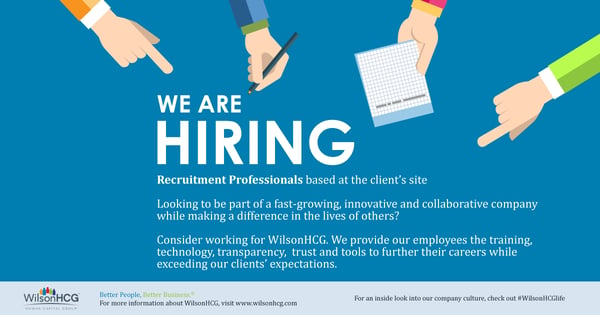7 Essential Job Description Components in a Candidate-Driven Market
April 5, 2018Why is recruitment marketing so important? We live in a candidate-driven market. Candidates know their value; whether passive or active, they won’t budge for a role that doesn’t suit their personal and professional aspirations. Further, more than 50 percent of applicants still come from social media searches and job boards – using platforms like corporate social media, career pages, Glassdoor and Indeed. This is often their entry point to your organisation. But where to employers fall short?
Too many job descriptions and advertisements are written with the belief that the employer is doing the candidate a favor. This attitude instantly discourages your audience. Today, we MUST write from the perspective of the candidate, pay careful attention to word choice, length and grammar, and present opportunities in a way that incite candidates to take the next step. The following features the essential components of an SEO-friendly, modern and candidate-driven job advertisement.
1. Grab Attention!
According to Indeed, job seekers spend just 49 seconds reading a job advertisement or role description before moving on. In this short amount of time you need to grab their attention, whether that involves your recruitment marketing post about open roles or within the job description itself. This begins with your very first sentences! In as few words as possible, describe the role itself, what the candidate needs to know about the company – and what you have to offer them in terms of a “career”, as learning and development are now THE driving factor in candidate decisions.
2. Authenticity & Transparency
In fact, in WilsonHCG’ Fortune 500 Top 100 Employment Brands report, we found that leading companies enhance the candidate experience by authentically conveying culture, inclusivity and "day in the life" using multimedia content, employee testimonials, Q&As and AI-driven chat functions.
For example, the No. 1 employer brand in our report, Johnson & Johnson, include in their job descriptions employee-led videos speaking to the range of opportunities for personal fulfillment, career flexibility and professional growth, as well as insight into compensation, investment opportunities, work-life balance, medical benefits and diversity. Many companies are enhancing their job descriptions in this way – and they’re leveraging their employees (e.g., testimonials) to tell authentic stories.
3. Keywords, Keywords, Keywords
The more keywords you include, the greater chance candidates will notice your advertisements while perusing open roles, and the greater chance search engines will bring up your advertisement. According to Monster’s "Keywords Are the Key to Making your Job Posting Searchable":
"Search engines are only concerned with text, so your best chance to have the posting appear in search results is to integrate keyword phrases throughout your job listing. Along with the job title you’ve chosen, select 3-5 related terms to use throughout the copy to increase the relevance of the page. Do not overuse any keyword phrase. To test for overuse, read the description out loud. If it sounds awkward, reduce the number of instances for that phrase."
4. Craft a Relevant Role Title
You need an accurate job title to optimise the chance candidates will click on your job advertisement. If this isn’t in your control, use the opportunity to consult with leadership. Vague or general-sounding job titles are more likely to be missed, while silly titles like “time ninja” won’t show up in search engines.
Say you’re looking for a Key Account Manager for an IT company who brings a strong background in selling software products. Rather than “Key Account Manager” it would behoove you to state “IT Sales Manager”. This title is not only more broad and will reach more candidates, it’s less generic. By inserting IT, you also let candidates know the industry you're hiring for. Precision and accuracy ensures you grab the attention of relevant candidates, including ones at the right level of seniority.
5. Keep It Simple
Today’s professionals are efficient; in return, they demand efficiency. And yet, 70 percent of candidates say job descriptions are unclear. Job descriptions, visually and grammatically, need to be clear and concise. Toward this end, job advertisements should be no more than 500 words. My recommendation? Less than that! Use bullet points. Remove hyperbole. Respect your audience’s time with brevity in a way that’s clear, informative, and gives them a reason to engage/apply even if passive.
6. Check (then Double Check) Your Grammar
Nearly 60 percent of job seekers will bypass applying for a role if they notice grammatical errors in a job advertisement or role description. Proofreading your content takes minutes, while failing to do so can result in permanent loss of interest. Grammar aside, carefully reviewing your content, links and sources ensures your communities are confident in the information they’re receiving.
7. Guide Candidates to the Next Step
Give your candidates the action step! Always include the email address of a direct contact, a link to your career website, or where exactly they should go in order to apply. Ambiguity with regard to the next step can spell doom for any job description.
The job description and advertisement design components of recruitment marketing play a pivotal role in talent acquisition. They're also low-hanging fruit, something you can optimise immediately while achieving long-term benefit. Start today!
About WilsonHCG
WilsonHCG is an award-winning, global leader in total talent solutions. Operating as a strategic partner, it helps some of the world’s most admired brands build comprehensive talent functions. With a global presence spanning more than 65 countries and six continents, WilsonHCG provides a full suite of configurable talent services including recruitment process outsourcing (RPO), executive search, contingent workforce solutions, talent consulting and talent intelligence.



